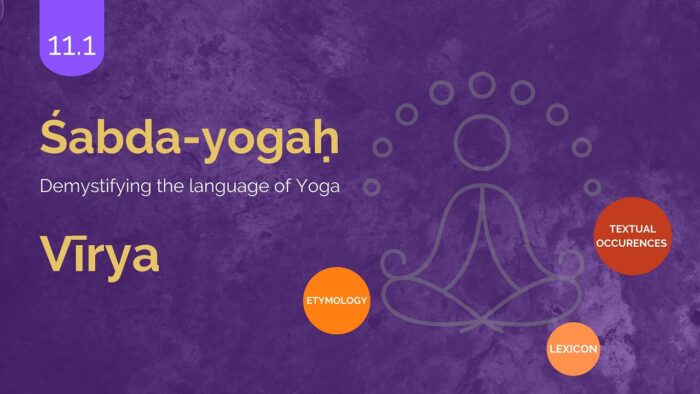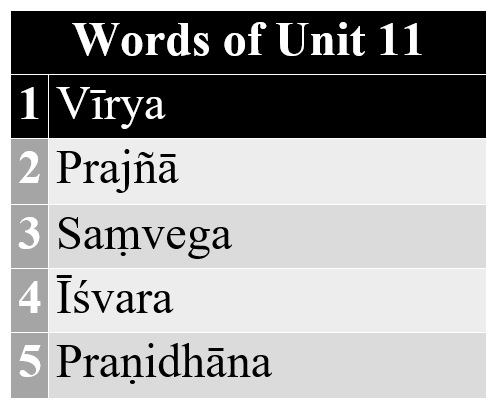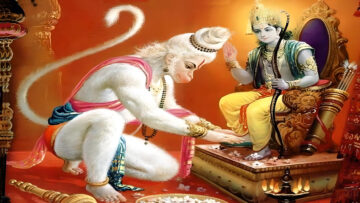Introduction
In this series, Yogic terminologies will be taken up and their –
- Etymological analysis,
- Lexical descriptions and
- Textual occurrences in Yogic literature and their commentaries, as available, will be presented. And finally observations will be made on the references.
Three texts – Yogasūtra, Haṭha-yoga-pradīpikā and Bhagavad-gītā are consulted for textual occurrences portion.
Śabda-yoga is intended to help students, teachers, and professionals of Yoga to develop a sound grammatical, contextual, and thereby an authentic and immersive understanding of Yoga terminologies.
List of Words
We will take up important Yogic terms from Sūtra-s 1.20 – 23. The terms that will be analyzed in this Unit are –
11.1 Vīrya
Etymology
वीर + यत् = वीर्यम्
vīra + yat = vīryam
Vīrya is a word derived from a Noun.
The noun is vīra
The suffix is Yat.
The word vīra refers to a warrior or a brave person. The suffix yat is added to indicate the meaning tatrasadhu – capable/appropriate in that. This suffix is added based on the Grammatical rule तत्र साधुः (aṣṭādhyāyī4.4.98)
Hence the derivative statement would be – वीरे साधुवीर्यम् vīre sadhu vīryam – that – bravery or great energy and effort – which is appropriate in a soldier or a brave person.
Lexicon
There are 3 entries in Amarakośa on this term.
उत्साहोऽध्यवसायः स्यात्स वीर्यमतिशक्तिभाक् 1.7.29.2.3
utsāho’dhyavasāyaḥsyātsavīryamatiśaktibhāk
utsāha, adhyavasāya, vīrya – these words indicate the meaning prowess.
शुक्रं तेजोरेतसी च बीजवीर्येन्द्रियाणि च 2.6.62.1.5
śukraṃtejoretasī ca bījavīryendriyāṇi ca
śukra, tejas, retas, bīja, vīryaindriya – these terms indicate the male semen
वीर्यं बले प्रभावे च …3.3.155.1.1
vīryaṃ bale prabhāve ca –
The word vīrya is used in two meanings – strength and capability/prowess
It could thus be seen, that three meanings – strength, prowess and semen are the meanings emerge from the lexicon.
Textual Occurrences
Yogasūtra– 2
There are two references to the term in this text.
1) First occurrence:
श्रद्धावीर्यस्मृतिसमाधिप्रज्ञापूर्वक इतरेषाम् ॥ १.२० ॥
śraddhāvīryasmṛtisamādhiprajñāpūrvakaitareṣām .. 1.20 ..
This sūtra discusses the Upāya-pratyaya-samprajñāta-samādhi (that state of Samādhi which are attained with Upāyas – means). The Upāyas are listed in this Sūtra itself which are śraddhā, vīrya, smṛti, samādhi and prajñā. In this context the word Vīrya is described by classical commentators of the text as follows –
a) utsāha – enthusiasm by Bhoja and SadāśivaBrahmendra in their commentaries. (वीर्य्यमुत्साहः – vīryyamutsāhaḥ)
b) Prayatna – effort by the Maṇiprabhā and Yoga-siddhānta-candrikā (वीर्यंप्रयत्नो जायतेvīryaṃprayatnojāyate)
c) Dhāraṇā– A firm state of mind/conviction by the Pradīpikā commentary (वीर्यं तद्विषया धारणाvīryaṃtadviṣayādhāraṇā)
Thus, based on the traditional commentaries enthusiasm, effort and firm conviction to follow the practices of Yoga to attain Samādhi constitutes the meaning of the term Vīrya in this Sūtra.
2) Second Occurrence
ब्रह्मचर्यप्रतिष्ठायां वीर्यलाभः ॥ २.३८ ॥
brahmacaryapratiṣṭhāyāṃvīryalābhaḥ .. 2.38 ..
Brahmacarya (non-indulgence in sensual activities) is part the five yamas that is the first limb of aṣṭāṅgaYoga. This Sūtra states that – on firmly following Brahmacharya – Vīrya is attained (Vīryalabha). Most commentators beginning form VācaspatiMiśra– agree that the meaning of the term Vīrya in this context refers to Sāmarthya – capability. They go on to describe that the capability here refers to those capabilities that lead to perform extraordinary feats.
Bhagavad-gītā
There are four references to the word Vīrya in this text. Two occurrences are in the first chapter and other two are in the eleventh chapter. A brief discussion on that is as follows –
Chapter 1
धृष्टकेतुश्चेकितानः काशीराजश्च वीर्यवान् ।
पुरुजित्कुन्तिभोजश्च शैब्यश्च नरपुङ्गवः ॥ 1.५ ॥
dhṛṣṭaketuścekitānaḥkāśīrājaścavīryavān .
purujitkuntibhojaścaśaibyaścanarapuṅgavaḥ .. 1.5 ..
युधामन्युश्च विक्रान्त उत्तमौजाश्च वीर्यवान् ।
सौभद्रो द्रौपदेयाश्च सर्व एव महारथाः ॥ 1.६ ॥
yudhāmanyuścavikrāntauttamaujāścavīryavān .
saubhadrodraupadeyāścasarvaevamahārathāḥ .. 1.6 ..
In the verses of the first chapter the expression vīryavan is found – that describes various kings who have assembled for the Mahabharata war – and portrays them as – full of prowess (Vīryavan).
Chapter 11
अनादिमध्यान्तमनन्तवीर्यमनन्तबाहुं शशिसूर्यनेत्रम् ।
पश्यामि त्वां दीप्तहुताशवक्त्रं स्वतेजसा विश्वमिदं तपन्तम् ॥ 11.१९ ॥
anādimadhyāntamanantavīryamanantabāhuṃśaśisūryanetram .
paśyāmitvāṃdīptahutāśavaktraṃsvatejasāviśvamidaṃtapantam .. 11.19 ..
नमः पुरस्तादथ पृष्ठतस्तेनमोऽस्तु ते सर्वत एव सर्व ।
अनन्तवीर्यामितविक्रमस्त्वंसर्वं समाप्नोषि ततोऽसि सर्वः ॥ 11.४० ॥
namaḥpurastādathapṛṣṭhatastenamo’stutesarvataevasarva .
anantavīryāmitavikramastvaṃsarvaṃsamāpnoṣitato’sisarvaḥ .. 11.40 ..
The next set of two references is from the 11th chapter where the Viśvarūpa – the cosmic form of Bhagavān is described. In both occasions – the lord is described as Anata-vīrya – the one who is endowed with endless prowess and capability.
It is interesting to note that – while the Kings mentioned in the first chapter have prowess (vīryavan) – the prowess or the capability of the Lord is limitless (Anatavīrya).
Haṭha-yoga-pradīpikā
There is just one reference to the word in this text. It is as follows –
हठविद्या परं गोप्या योगिना सिद्धिमिच्छता ।
भवेद् वीर्यवती गुप्ता निर्वीर्या तु प्रकाशिता । ॥ 1.११ ॥
haṭhavidyāparaṃgopyāyogināsiddhimicchatā .
bhavedvīryavatīguptānirvīryātuprakāśitā . .. 1.11 ..
This verse states that the knowledge of Haṭha has to be maintained secretly (discretion has to be exercised before teaching). Only then it would be efficacious (vīryavati). Else it will be of no effect.
As evident two terms Vīryavatii and Nirvīrya – both derivations from the term Vīrya is seen here – which refers to – being efficacious and ineffective.
Tabulation of Textual References 11.1
Summary &Observations
It could be observed that there are various shades of meanings that emerge for the term Vīrya based on the Grammatical derivations, lexical references and textual occurrences.
- Based on these references it could be seen that – Vīrya refers to – 1) Bravery 2) Effort 3) Strength/ Prowess 4) Capability 5) Enthusiasm 6) Firm Conviction 7) Potency (effective) 8) semen
- It could be noted that selfsame term Vīrya is mentioned as a tool (Yogasūtra 1.20) and Vīrya is also an outcome (2.38) in Yogasūtra.
- The human vīrya – prowess (chapter 1 of Bhagavadgita) and vīrya of cosmic proportions (Anantavīrya) are presented.
- Vīrya in the battlefield (Chapter 1 in bhagavadgtia) and Vīrya that is achieved through the Yogic practices (Yogasūtras 2.38) could also be noted.
- Also, it could be noted that – usages such as Vīryavati, Nirvīrya, Anantavīrya, Vīryavan – are found in these texts and references.
- It could also be noted that in Yogic practices Gopana – exercising discretion in imparting knowledge determines whether Yogic knowledge will be endowed with vīrya or not.
In conclusion – the various shades of meanings, various contexts of occurrences and the contrasts that emerge from juxtaposing the selfsame term in various contexts- makes the study of the term Vīrya in the Yogic context very interesting and enriching.
Unit 11 To be Continued…
Disclaimer: The opinions expressed in this article belong to the author. Indic Today is neither responsible nor liable for the accuracy, completeness, suitability, or validity of any information in the article.













